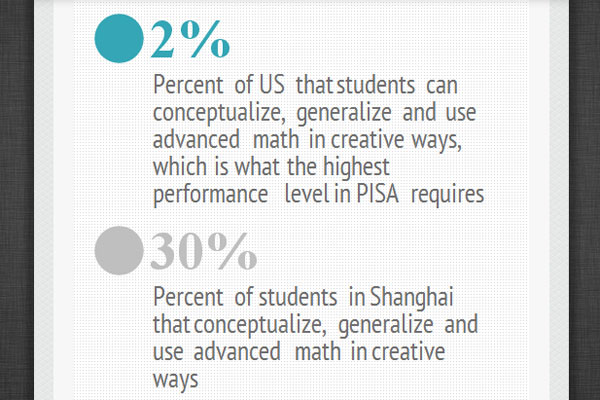Test less, create more
A student’s view on education in the US

Recent international testing suggests our high schools might do better to do less standardized testing and more creative, out-of-the-box thinking.
December 17, 2013
The Organization for Economic Cooperation and Development (OECD) released its findings on its Program for International Student Assessment (PISA) and shocked many people with the United States’ low ranking. The program tests students ages 15 and 16 in mathematics, reading, and science. The United States came in 36th place with Shanghai taking the top spot. The United States’ scores were below average in mathematics and only average in science and reading. Many people in the US have begun to worry about the dropping scores.
Despite what seems to be the common belief, the US has never been at the top of the table. Since PISA began, the US has always been at about the median of the countries tested. So the idea that the US has fallen far behind the rest of the world is a misconception. The US has not fallen at all, but the lack of improvement is what is concerning. Many of the countries that top OECD’s list have been very rapidly advancing in the last decade in development, and therefore also in education. These countries have risen up from a lower standing whereas the US has stayed consistent.
Seeing that the US has hovered around the same spot for the last 30 years can it really be argued that this lower ranking in education has caused a slip in the US’s standing in the world? In the last 30 years the US has not slipped as a world superpower in terms of technology, economics, or influence. So clearly our so called “failures in education” have not hurt us that much. The reality is that even though US students may not rank top in the world in their standardized testing, they are still just as prepared to enter the world after schooling.
First it is not only the United States that is being out performed. Other large industrial giants like Germany and the United Kingdom are also dropping on the scale. The United Kingdom came in at 26th. East Asian countries have been surpassing all the Western nations in test scores. So it would be hard to believe that the US and the majority of European countries are suddenly doing something wrong with the way they teach. Instead its far more likely that East Asian schools have just been employing newer more successful methods for improving their scores.
What has made American school systems great in the past is their focus on creative thinking. In an attempt to improve our standardized test scores, which bureaucrats seem to think is the only thing that matters in education, we have placed the focus on standardization and compliance. Not just for our students but for our teachers as well. Nowadays teachers get fired for breaking from the strict core standards or being unique in their teaching. The notorious Asian cram schools are a thing of the past and have been replaced by intuitive and creative teaching. It is that change that has caused these Asian schools to become the best in the world, not the regimented testing curriculum that the US believes it is. In an attempt to emulate the success of these Asian schools the US has missed the actual reasons they have been successful. We are trying to move forward with programs that Asian schools have left in the dust.
Keep in mind that what works for them may not be a good fit for us. The culture of America’s youth is very different from these East Asian countries. Kids there spend more time in school but sports and activities are almost never available at school. There is all kinds of science and studies supporting the claim that enrichment in activities improves overall intelligence and prepares kids more for the world. Being able to participate in a sport gives kids a very valuable mental stance. The focus needed to balance school work and sports, oftentimes more than one, is a huge life skill. Music has been shown time and time again to improve all forms of academic thinking. Sports and activities require the ability to plan, organize, and budget time. They require practice and repetition. It is the participation in these things that give American kids an advantage after schooling.
If there is one major change I believe needs implementation it is improved attention to teachers. Shanghai’s education system invests in teaching staff by offering training and high salaries. The teachers there are paid much better and are more professional. In the US the position of teaching has suffered. It is a hard, under-appreciated job, there is not the same incentive there once was to become a teacher. In these Asian countries they providing incentives for high-achieving students to enter the profession. It might be a good idea for the US to do the same. Also the US has one of the best university systems in the world. Perhaps the lower education system is not as efficient as elsewhere but the higher education system is world renowned. International students come from all over to take part in our colleges. So with this in mind lowering the cost of college is hugely important. High schools in Europe begin career specific training in high school. There are both benefits and setbacks to that.
To me it seems crazy to expect students to decide what they want to do for the rest of their lives even earlier, but it does mean that college is basically a necessity in the US? It seems to me that other countries are more prepared educationally earlier on but the US equates out after college. So if the US cares so much about its young people being prepared educationally we must lower the cost of college and make it realistically possible for everyone.



Lisa Aulerich-Marciniak • Dec 17, 2013 at 3:04 pm
Interesting piece, Mike. Thanks for reporting on this.
Here are a couple more things to think about when looking at these stats and rankings:
1) Relative wealth has a lot to do with educational outcomes. When separated out, our wealthy schools in the US do very well in comparison to the rest of the world. Part of that comes from opportunities afforded to the children of well off communities both at home and at school. Unfortunately, there is a great wealth gap in our country, and our poor schools suffer from a lack of the resources that help kids to learn. In other countries, there are incentives for the best teachers to teach in the schools in the poorest areas. Funds are funneled there, too, to make sure that these kids have what they need to catch up and keep up with their wealthier compatriots.
2) It is interesting that the graphics used compare ALL of the US to China when talking about expenses, but only to Shanghai (the wealthiest section of China) when comparing math scores. That would be like comparing the results from the state with our best schools here in the US to all of China. My guess is we’d come out looking pretty good if that’s what we did.